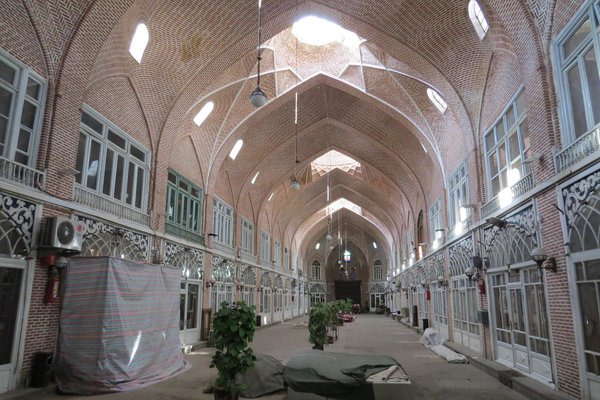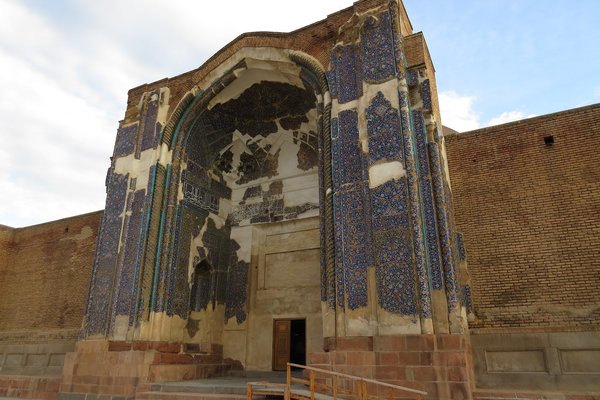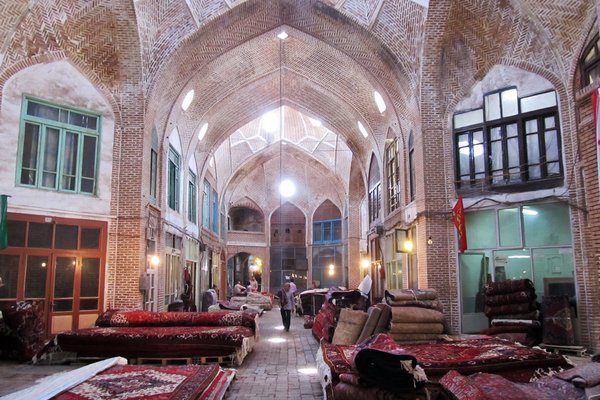Iran
Tabriz Bazaar
The Tabriz Historic Bazaar Complex is an example of commercial architecture with a number of specialized buildings.
Tabriz was located on a centuries-old east-west trading route. The Bazaar flourished mainly between the 12th and 18th centuries. During that era, Tabriz became the capital city of the Safavid kingdom and remained an important commercial and economic center afterward.
Community Perspective: This covered bazaar is one of the world’s largest. Besides numerous shops (which feel quite modern), you can find more than 20 caravanserais and a Friday Mosque in its interior. To “add value” to the visit experience it is worth trying to understand and chase down the different social and architectural elements of the Bazaar as described in the AB evaluation and the nomination file.
Site Info
Official Information
- Full Name
- Tabriz Historic Bazaar Complex (ID: 1346)
- Country
- Iran
- Status
-
Inscribed 2010
Site history
History of Tabriz Bazaar
- 2010: Inscribed
- Inscribed
- Type
- Cultural
- Criteria
- ii
- iii
- iv
Links
- UNESCO
- whc.unesco.org
- Official
-
- itto.org — Tabriz
- Related
-
- openarchive.icomos.org — ICOMOS: Tabriz Historical Bazaar in the context of Change
- ardmediathek.de — Schätze der Welt: Tabriz - Der grosse Basar
- archnet.org — Archnet: Rehabilitation of Tabriz bazar
All Links
UNESCO.org
- whc.unesco.org — whc.unesco.org/
Official Website
- itto.org — Tabriz
Related Resources
- openarchive.icomos.org — ICOMOS: Tabriz Historical Bazaar in the context of Change
- ardmediathek.de — Schätze der Welt: Tabriz - Der grosse Basar
- archnet.org — Archnet: Rehabilitation of Tabriz bazar
News Article
- May 9, 2019 foxnews.com — Iran firefighters put out blaze at historic bazaar in Tabriz
Community Information
- Community Category
- Urban landscape: Arabic and Middle Eastern
Travel Information
Red Zone Travel Advisory
Iran fully off-limits
Recent Connections
-
Perfect Inscriptions
2010 -
World Craft Cities
Carpets -
Red Zone Travel Advisory
Iran fully off-limits
Connections of Tabriz Bazaar
- Individual People
-
-
Marco Polo
-
Ibn Battuta
Although he reportedly spent almost no time there...
-
- History
-
-
Located in a Former Capital
From the Mongol invasion up to 1501 was the capital of various Turkoman states centered on Azerbaijan and, from 1501-48 of the Safavid Iranian Empire of Shah Ismail I -
Silk Roads
Classic Land Route; "one of the most important commercial centres on the Silk Road" (AB ev)See en.unesco.org
-
- Architecture
-
-
Brick architecture
Buildings are made of brick -
Timurid Architecture
Blue (Kaboud) Mosque
-
- Damaged
-
-
Destroyed or damaged by Earthquake
In 1780, at the beginning of the Qajar dynasty, the most destructive earthquake in the dense seismic history of Tabriz completely destroyed the town; it was, however, rapidly rebuilt (AB ev)
-
- World Heritage Process
-
-
Already inscribed still on T List
The Kaboud Mosque a.k.a Blue Mosque, Goi Masjid, Jahanshah mosque. Tabriz Bazaar includes 28 different Mosques within the boundaries of its 3 inscribed zones. In the Nomination File (page 184) the Kaboud mosque is referenced as M28 and is used as the title of the 2nd of the zones viz - "1346-002 Kaboud Mosque" -
Perfect Inscriptions
2010
-
- Religion and Belief
-
-
Notable mosques
28 mosques in the Bazaar area (AB ev)
-
- Human Activity
-
-
Spice Route
"Tabriz is the most famous trade city of Asia, because caravans bring all types of goods. They bring silk, diamond, pictured cotton, cinnamon and spices from Tatarstan, Uzbekistan, Tibet, China and eastern India." (Nomination file p. 261) -
Locations for playing sport
Garshāseb Zorkhānāsi: a palestra (nom file)
-
- Constructions
-
-
Icehouses
Tabriz Bazaar includes 1 icehouse (AB ev) -
Bazaars and Market Halls
-
Caravanserai
Himmat-Ali Sarāyi, Kishmishchilar Sarayi -
Baths
At present, there are four Hammāms inside bazaar complex including Seyyed Golābi Hammām. (nom file) -
Mausolea
Sāhib-ul-Amr Mausoleum (nom file)
-
- WHS on Other Lists
-
-
World Craft Cities
Carpets -
Aga Khan Award for Architecture
Rehabilitation of Tabriz Bazaar, Tabriz, Iran (2013)
-
- Timeline
-
-
Built in the 13th century
The most prosperous time of Tabriz and its bazaar was in 13th century when the town became the capital city of the Safavid kingdom. (wiki)
-
- Science and Technology
-
-
Libraries
Jafaryya Library, Kalkatachi Library (nom file)
-
- Visiting conditions
-
-
Red Zone Travel Advisory
Iran fully off-limits
-
News
- foxnews.com 05/09/2019
- Iran firefighters put out blaze at…
Recent Visitors
Visitors of Tabriz Bazaar
- Afshin Iranpour
- Alexander Barabanov
- Alexander Lehmann
- Alexander Parsons
- A. Mehmet Haksever
- Ammon Watkins
- Artur Anuszewski
- Ask Gudmundsen
- Atila Ege
- AYB
- BaziFettehenne
- Bernard Joseph Esposo Guerrero
- Can SARICA
- David Marton
- Els Slots
- Erik Jelinek
- Fan Yibo
- Hammeel
- Harry Mitsidis
- henryjiao18
- Ivan Rucek
- janis
- Jean Lecaillon
- Jonas Kremer
- Joyce van Soest
- Knut
- LaVale
- Loic Pedras
- Maciej Gil
- Martin
- Martina Rúčková
- Miloš Tašković
- Morodhi
- Nihal Ege
- Roman Bruehwiler
- Solivagant
- Stanislaw Warwas
- Szucs Tamas
- Thomas Buechler
- Timothy C Easton
- Tinamu
- Truls Brekke
- usagi1974
- Wojciech Fedoruk
- Zizmondka
- Zoë Sheng
Community Reviews
Show full reviews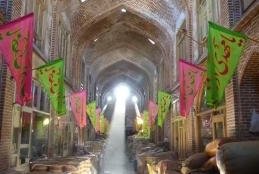
A few comments additional to Els’s thorough review
a. We visited first in the late afternoon and then again briefly the next morning to catch up on some areas which had been closed. It was a surprise to us to discover that, rather contrary to “popular belief” regarding a country which “stays up late”, a lot of the bazaar closes for the day around 4-5pm. Many areas of the bazaar are primarily wholesale (or even manufacturing) locations and their “business” is done early, unlike that of the tourist and gold etc areas! This early closure particularly impacts the Carpet Bazaar (The Mozaffarieh Timcha) if you want to see that (it is quite nice to watch the “carpet finishers” working on the floor of this area). You may not even know that such areas exist as they close off access from the main Bazaar by shutting their enormous mediaeval doors and you would have no idea of what lies behind.
b. To “add value” to the visit experience it is worth trying to understand and chase down the different social and architectural elements of the Bazaar as described in the AB evaluation and (more fully) in the Nomination file (Sarays, Timchas, Rastas, Charsugs, Dalans and Bazarchas!). Their names are usually marked by brass plates within the bazaar. The essence of Tabriz Bazaar’s case for OUV lies in this range of architectural and social spaces.
c. Maps of the main covered bazaar are as rare as hens’ teeth. Our guide managed to …
Keep reading 0 comments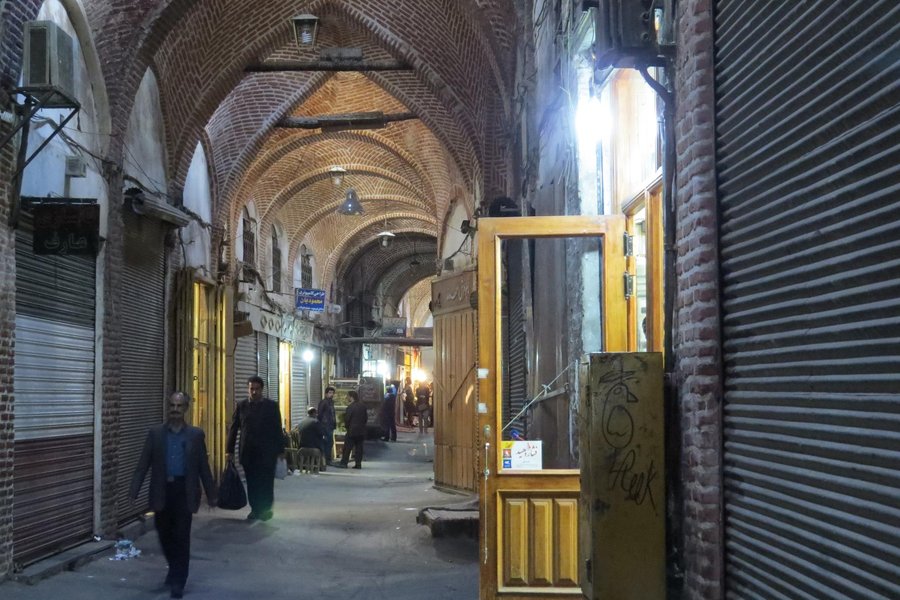
The Tabriz Historic Bazaar Complex has been declared a WHS because of its original layout and architecture. The nomination file goes into extreme detail about Iranian bazaar types and customs; this apparently is “a central bazaar with radial gate-bazaars”. The 3 inscribed locations are the Grand Bazaar and 2 of the remaining secondary bazaars. It’s also one of the oldest bazaars still in use: Tabriz was already a bustling town in the 13th century, when it was an important commercial stop on the northern route of the Silk Road through Iran.
We arrived at the Grand Bazaar late in the afternoon. It still is a popular shopping district in this city of 1.5 million inhabitants, and many shoppers were about. Both modern necessities such as kitchen utensils and traditional goods, like nuts and spices, are sold. The figs especially are to die for, soft and sweet - nothing like the dried-out objects you’ll find in supermarkets in Europe. Despite the bazaar’s age, it does feel quite modern and not as atmospheric as for example the medinas of Fez and Marrakech. People in my tour group who had been to Aleppo, the most similar WHS because it’s also a covered bazaar, preferred that one over Tabriz, too.
In the bazaar’s back alleys and behind closed doors, there is more to discover than appears at first sight. The bazaar not only has a commercial function, but it also provides a social and religious one. We had a quick look at a huge …
Keep reading 0 comments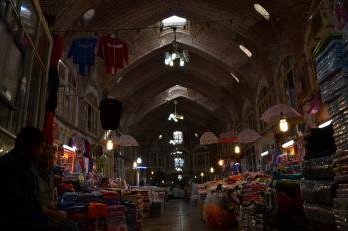
Visited September 2013.
If you get to Tabriz, sooner or later you will end up in the covered bazaar some say the biggest in the world. Few years ago we still had two biggest bazaars in the world - the second one being Al-Madina Souq in Aleppo, but what happened to the Syrian one, we all know and shame on all of us for that.
Tabriz is a very big city and the bazaar is not centrally located - it used to lie in the center of the town but as Tabriz became the main trading post between Turkey and Iran, most of the city moved southward. But the bazaar remains the real heart of the city if not of the whole West Azerbaijan. The main entrance is easy to miss, but don't worry you can always use one of the small gates.
What you can expect? A labyrinth-like kingdom where you can find anything you wish. Carpet, gold, spice, perfume, shoes, food, things you need and things you cannot even name - all's there. More than 20 timches (big vaulted halls), hundreds of alleys and thousands of shops. Go there in the late afternoon! And don't be afraid of the crowd! People are very friendly, they are business people but will find time to serve you a cup of tea or coffee.
In the bazaar itself there are more then 20 caravanserais and Friday Mosque with a brick vaulted interior. In the western part of the bazaar you can …
Keep reading 0 comments
I am from Tabriz. Interesting part of memories about Tabriz Bazaar goes back to my childhood time even before grade school walking with my family in this wonderful and naturally well warmed covered places watching shops after shops with almost anything a child might think about,while it was snowing with hard winter whether outside. In summer, just avoiding the heat of mid-day sun,I used to enjoy walking in this covered and naturally well air-conditioned cool air of any Tabriz Bazaars.
In my teen years I had my 25 minutes fast walking to school or back to home going through three different connected bazaars with my teen friends avoiding snow and cold weather in winter and heat of of late spring days.
One should be in these bazaars to see the wonder of the world miles after miles which was completed almost over 7 centuries ago. I think the creation of miles of Bazaar in Tabriz was one of the Wonder of the world. Visit that place if you are interested to see a Wonder of the world.
Keep reading 0 comments
